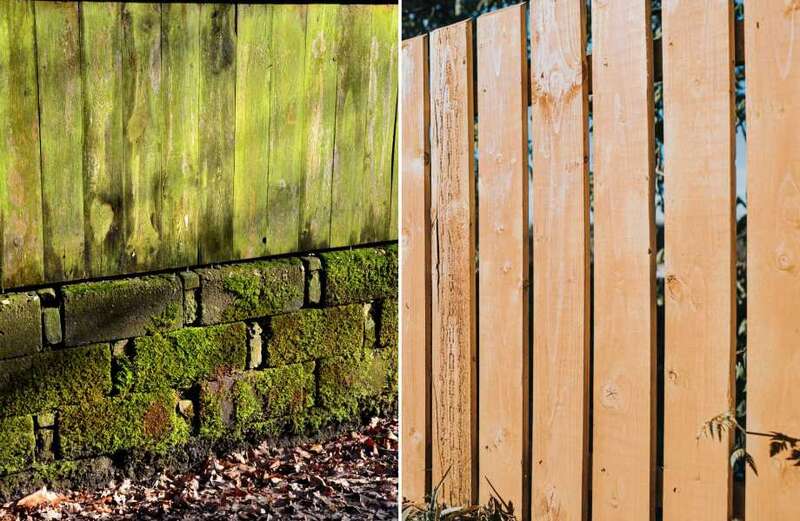ARE your fence panels green with slimy algae?
Fear not, a garden expert has shared the best ways to get rid of it, and the products you shouldn’t be using.


Fabulous spoke exclusively to Nick Ee, product, and training manager at BLACK+DECKER about why fences ave algae and how to get rid of it.
He said: “Fence algae is a common issue that occurs on fences throughout the year and wooden ones are particularly prone to the algae growth.
“This algae growth is typically caused by a combination of factors including moisture, shade, lack of air circulation and organic matter – knowing these can help prevent algae growth in the future.
 I'm a property expert - my guess for the cheapest time to buy a home this year
I'm a property expert - my guess for the cheapest time to buy a home this year
“Algae prefers shady areas so if your fence is in a location with limited sunlight, it creates the perfect environment for algae to flourish which often can’t be avoided.”
He added: “To prevent or combat fence algae you should consider regularly cleaning your fence, trimming back nearby vegetation to allow for more sunlight, and treating the wood with appropriate sealants or coatings to minimise moisture absorption.
“Furthermore, if this sounds like too much upkeep I would recommend opting for an algae-resistant wood.”
When it comes to cleaning algae there are a few ways you can do so and Nick discussed them all, and the one product not to use - bleach.
Pressure washer
The expert explained: “One of the best and most effective ways to clean algae from fences is to use a pressure washer.
"But it is important to follow these steps to ensure you do it correctly without damaging the wood or other materials."
How to clean fence algae with a pressure washer
“First, you’ll want to clear the area by removing any obstacles or debris near the fence that could interfere with the cleaning process.
“Make sure to move any nearby plants out of the way as well because the high pressure could damage them.
“For this sort of cleaning job, you’ll need a pressure washer with a 125 Bar Max pressure, and I would suggest using a wide angle or fan nozzle attachment to distribute the pressure evenly and prevent damage to the wood.
 Inside Camilla's £850k 'guilty pleasure' country pad - and Charles 'hates' it
Inside Camilla's £850k 'guilty pleasure' country pad - and Charles 'hates' it
“If you’re finding the algae to be quite stubborn, you may want to use a cleaning solution made from a mix of water and mild detergent or a specialised algae cleaning will work really well to remove the stain.”
He continued: “When cleaning the fence, I would recommend standing a few feet away to avoid damaging the wood with excess pressure.
“Hold the pressure washer nozzle at a 45-degree angle to the fence, aiming downward ad working in small sections, starting at the top and moving downward.
“Once you’ve cleaned the fence and all algae is removed, let it air dry before applying a sealant to prevent growth in the future.”

Bleach
He said: “Using bleach can be an effective way to clean algae from a fence, but it should always be done with extra precaution to avoid damage to the fence and surrounding areas.
“If your fence is wooden, particularly if it's stained or painted, using bleach will fade the colour and varnish.
“So consider using a less harsh cleaner specifically designed for wood.”
Why you should avoid using bleach
Bleach poses harmful impacts to the environment in many ways.
Specifically, bleach is a major concern for water quality, soils, and wildlife.
Bleach is also considered an unstable chemical solution, meaning it is highly reactive, corrosive, and can easily bind with other elements to create a new compound.
Washing up liquid or white vinegar
Nick added: “If you’re looking for a cheaper alternative, a solution of washing up liquid and water or white vinegar can be used to remove the algae."
How to clean fence algae with white vinegar
“To remove algae from a wooden fence effectively and affordably, you can prepare a solution of white vinegar and water in spray bottle or garden sprayer.
“Spray the vinegar solution generously over the algae-covered areas of the fence and let sit for around 15-20 minutes to let the acidity of the vinegar work its magic.
“You’ll need to scrub the solution in using a soft brush or broom and then rinse off thoroughly using either a garden hose or pressure washer to wash away any remains of vinegar and algae.”



































